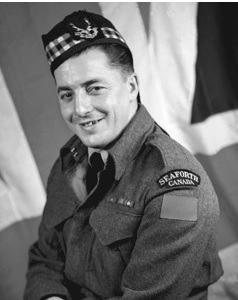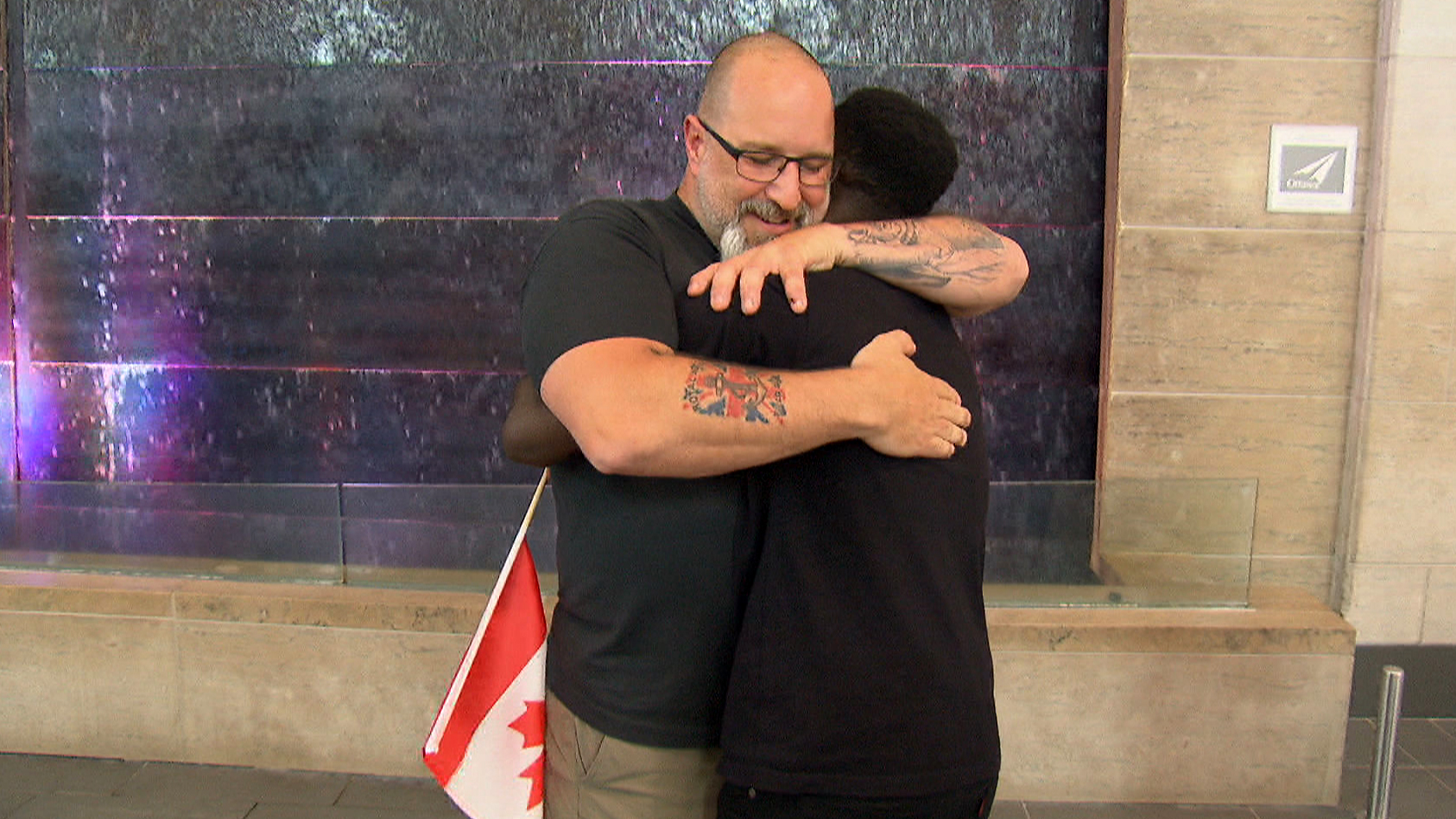Canada Remembers Times - 2019 Edition - Page 3
Three faces of freedom
Canadians served with great courage during the Second World War. Three of the bravest of the brave were awarded the Victoria Cross (VC)—the highest award for military valour.
Pilot Officer Andrew Mynarski
Photo: Department of National Defence
Pilot Officer Andrew Mynarski of Manitoba was a crew member in a Lancaster bomber that was attacked over occupied France on June 12-13, 1944. The pilot ordered his crew to parachute from the burning plane but Mynarski saw that the tail gunner, Pat Brophy, was trapped. He tried to free him but could not and Brophy told him to save himself. Reluctantly, Mynarski saluted his friend and jumped from the plane, his clothes on fire. Somehow Brophy survived the crash of the bomber but the severely burned Mynarski died. He had given his life to help another and was posthumously awarded the VC.
Major David Currie
Photo: Department of National Defence
Tens of thousands of Canadians fought in Normandy, France, in the summer of 1944. They were all brave, but Major David Currie from Saskatchewan stood out. He led an attack on a village in the Falaise Gap on August 18, 1944, in the face of fierce resistance from enemy tanks, guns and soldiers. Major Currie’s conduct and bravery in the face of danger set an excellent example to those under his command as he cheered his men on with encouraging words. For his great leadership under fire, he received the VC.
Sergeant Ernest “Smokey” Smith
Photo: Department of National Defence
Sergeant Ernest “Smokey” Smith of British Columbia apparently loved a good fight. He got a chance to demonstrate this in German-occupied Italy on October 21-22, 1944, when his position came under heavy fire during an enemy attack. Using whatever weapons he could lay his hands on in the thick of the battle, Smith singlehandedly destroyed a German tank, took out attacking soldiers, helped a wounded friend to safety, and then returned to guard the road until reinforcements arrived. His persistence and devotion to duty earned him the VC.
Healing hugs
Sammy Sampson greeting his old friend Sammy Tuyishime in the Ottawa airport in 2018.
Photo: Leah Hansen/CBC Licensing
This year marks the 25th anniversary of the Rwandan genocide of 1994, one of the most horrific events of the 20th century. As many as one million people were massacred in the African country over a mere 100 days.
Canadian Armed Forces members served in Rwanda and bearing witness to such brutality left a deep and lasting impact. Sammy Sampson was amongst the first troops to arrive in the region in the aftermath of the genocide. Seeing so many starving and suffering children, Sampson and his fellow Canadian soldiers wanted more than anything to support them, and helped establish a local orphanage.
Spending time with the children gave the weary Canadians some sense of normalcy amidst the chaos. One child, whose name no one knew, was drawn to Sampson, hugging the soldier’s leg the first time they met. Sampson and the boy formed such a bond that the orphanage Healing hugs named him Sammy. Sampson’s mission came to an end, but Rwanda remained a troubled land.
Years later, memories of Rwanda continued to haunt Sampson, and he feared that the orphanage children had not survived. Imagine how relieved he was to hear that little Sammy was alive and well! Now a grown man, Sammy Tuyishime continues to live in Rwanda and was able to connect with Sampson through social media. The two were determined to meet in person and reunited in Ottawa in June 2018.
Queen of the Hurricanes
A panel from a special comic book about Elsie MacGill that was published during the Second World War.
Image: Royal Aviation Museum of Western Canada
Tens of thousands of Canadian women answered the call to work in factories during the Second World War at a time when women in the Canadian military were not yet permitted to serve in combat roles. They contributed to the war effort by keeping our country’s industrial production growing and freeing up more men to fight overseas. However, not many women pitched in quite the way Elsie MacGill did!
Elsie MacGill was born in Vancouver, British Columbia, in 1905. She was remarkable in many ways, becoming the first woman to earn an electrical engineering degree in Canada and later was the first female aircraft designer in the world. She is best known for her work during the Second World War as the Chief Aeronautical Engineer supervising the production of the much-needed Hawker Hurricane fighter airplanes at a factory in Fort William, Ontario. Her efforts earned MacGill the nickname “Queen of the Hurricanes.”
Elsie MacGill received many awards including the Order of Canada, and she was declared a Person of National Historic Significance in 2007. She paved the way for many women, inspiring them and showing that any goal is attainable through hard work and determination.
Paying it forward
Corporal Satgunanathan in uniform.
Photo courtesy of Shangary Graham (Satgunanathan)
Shangary Satgunanathan was born in Sri Lanka. A civil war ravaged her country during her childhood and her family experienced regular bombings, forcing them to flee from the attacks. Eventually, some of Shangary’s family immigrated to Canada when she was a teenager. Settling in Toronto, it was a new beginning.
Shangary’s sense of adventure led her to join the Canadian Army Reserves. Years later, she served in a military hospital in Afghanistan with the Canadian Armed Forces. She witnessed many wounds of war and experienced the harsh reality that not everyone can be saved.
Shangary has retired from the military but serving in uniform was rewarding for her because she gained new knowledge about our country’s history and the sacrifices that had been made to keep Canada free. Joining the Canadian Armed Forces also gave Shangary the opportunity to give back to her adoptive nation and thank those who had served before her.
Canada’s “fightingest” ship
HMCS Haida docked in Hamilton.
Photo: Parks Canada
HMCS Haida was a Royal Canadian Navy destroyer that saw impressive service between 1943 and 1963. Named after the Haida First Nation, this powerful warship protected supply convoys from enemy attacks in the North Atlantic during the Second World War. In the lead-up to D-Day, HMCS Haida patrolled the English Channel, helping clear enemy vessels so that the Allied troops could come ashore on June 6, 1944. During the Korean War, the destroyer played an important role protecting the United Nation’s fleet, blocking enemy supply lines and even knocking out enemy trains on tracks skirting the shoreline. Credited with sinking more ships than any other Royal Canadian Navy vessel, HMCS Haida earned the nickname of Canada’s “most fightingest” ship.
This great piece of our country’s military history may have been turned into scrap metal had it not been for a small dedicated group from Toronto who purchased the decommissioned ship for $20,000. Canadians can now tour the decks, wardroom, engine room and mess of the last Tribal class destroyer in the world at the HMCS Haida National Historic Site in Hamilton, Ontario.
Did you know?
The First World War erupted 105 years ago on August 4, 1914. More than 650,000 Canadians would serve in this bloody conflict which finally ended in victory when an armistice was signed on November 11, 1918.
Canada’s impressive achievements helped our country earn new respect on the international stage but the price was steep, with more than 66,000 of our men and women in uniform losing their lives.
- Date modified:






